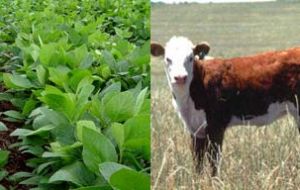MercoPress. South Atlantic News Agency
Soy displaces cattle as main farm activity in Argentina
 Of all the current camp options soy requires a lesser investment; prices remain strong and promise to remain strong
Of all the current camp options soy requires a lesser investment; prices remain strong and promise to remain strong Soy beans has become the main commodity of Argentina's rich farmland displacing other traditional industries such as cattle breeding and dairy farming, according to studies and statistics from the country's main breeders organization the Rural Society.
This cultivation season Argentina planted 16.9 million hectares with soy, 650.000 more than the previous year, making the oil seed agriculture's main money making production and fiscal resource. However the 2007/08 crop is estimated to reach 47 million tons, similar to last year's season because of lack of rainfall which is going to impact on yields. The "soyzation process" as it has been identified in Argentina has steadily advanced since 2002, taking prime land from other activities such as beef and dairy produce which made the country world known. Furthermore the Kirchner administrations insistence in keeping prices low for the domestic market has further discouraged cattle (fattening) breeders and dairy farmers during the last 24 months, according to the industries organizations. Soybeans on the other hand provide higher profits (international prices doubled in 12 months), demands less planting investment and are more resilient to adverse climatic conditions and diseases. "Of all the current camp options soy requires a lesser investment; prices remain strong and promise to remain strong; demand for oil and bio-diesel keeps growing and it's the crop less susceptible to suffer the lack of rainfall", said economist Ernesto Ambrosetti from the SRA Economics Studies Institute. However it has its drawbacks and the main soy organization admits it. "In vast areas soy has become a single cultivation" said Rodolfo Rossi from the Soy Association. And he warned many farmers are not involved in the necessary conservation of the soil since soybeans extract a high percentage of nutrients which need to be replenished. Rossi said that in other areas "soil management is adequate; direct plantation (no plough); fertilizers and winter crops, but in vulnerable areas where rotation of crops is essential it's not been done". And this situation could worsen since the price of fertilizers have on average doubled in the last twelve months. SRA numbers show that to plant a hectare of soy on average demands an investment of 180 US dollars, for any other crop it's 30 to 50% dearer. The last crop yield was three tons per hectare on average and this season is estimated in 2.8 tons, but soy reached 504 US dollars per ton on Friday in Chicago. With that level of prices and volume of production soy beans are an excellent deal for Argentine farmers. But also for the Argentine Treasury and the tax man: export duties last year represented 3.5 billion US dollars and this year soy beans are expected to contribute 5.2 billion US dollars. And soy is not relevant for Argentina's inflation index: 95% is exported, the bean and oil to China and the soy meal for animal feed to Europe and India.




Top Comments
Disclaimer & comment rulesCommenting for this story is now closed.
If you have a Facebook account, become a fan and comment on our Facebook Page!